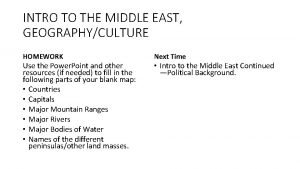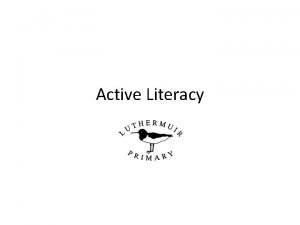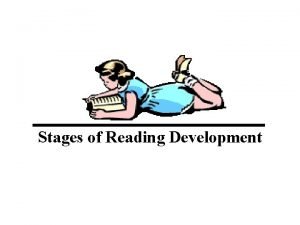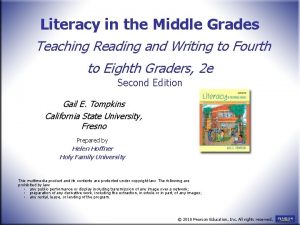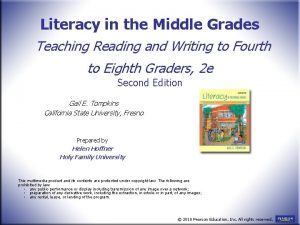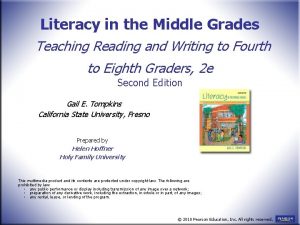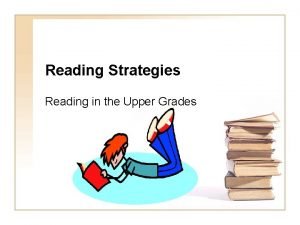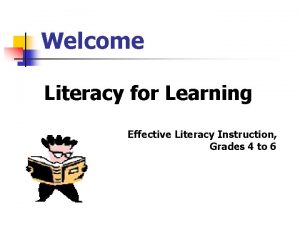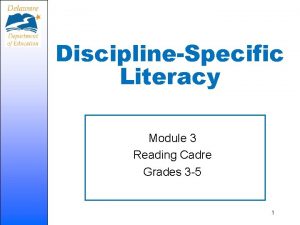Literacy in the Middle Grades Teaching Reading and











- Slides: 11

Literacy in the Middle Grades Teaching Reading and Writing to Fourth to Eighth Graders, 2 e Second Edition Gail E. Tompkins California State University, Fresno Prepared by Helen Hoffner Holy Family University This multimedia product and its contents are protected under copyright law. The following are prohibited by law: • any public performance or display including transmission of any image over a network; • preparation of any derivative work, including the extraction, in whole or in part, of any images; • any rental, lease, or lending of the program. © 2010 Pearson Education, Inc. All rights reserved.

Chapter 6 Choosing Words to Study n Tier 1: Basic Words n n Tier 2: Academic Words n n These common words are used socially in informal conversation at home and in recreational activities. These words are used more frequently in written than in oral language. Tier 3: Specialized Words n These technical words are content-specific and abstract. Literacy in the Middle Grades 2 e Gail E. Tompkins 2 © 2010 Pearson Education, Inc. All rights reserved.

Chapter 6 Levels of Word Knowledge n Level 1: Unknown Word n n Level 2: Initial Recognition n n Students have seen or heard the word or can pronounce it, but they don’t know its meaning. Level 3: Partial Word Knowledge n n Students don’t recognize the word. Students know one meaning of the word and can use it in a sentence. Level 4: Full Word Knowledge n Students know more than one meaning of the word and can use it several ways. Literacy in the Middle Grades 2 e Gail E. Tompkins 3 © 2010 Pearson Education, Inc. All rights reserved.

Chapter 6 n Vocabulary Instruction v v Immerse students in words through listening, talking, reading, and writing. Teach specific words through active involvement and multiple encounters with words. Teach word-learning strategies so students can figure out the meanings of unfamiliar words. Develop students’ word consciousness, their awareness of and interest in words. Literacy in the Middle Grades 2 e Gail E. Tompkins 4 © 2010 Pearson Education, Inc. All rights reserved.

Chapter 6 Word Walls n n n Words should be added as they come up in texts students are reading, not in advance. Students and teachers write interesting and important words representing all 3 tiers on word walls. Students use word walls during grand conversations, word study activities, and writing projects. Literacy in the Middle Grades 2 e Gail E. Tompkins 5 © 2010 Pearson Education, Inc. All rights reserved.

Chapter 6 When students encounter an unfamiliar word, they should: 1. 2. 3. 4. 5. Reread the sentence containing the word. Use context clues. Look for familiar root words & affixes. Try to pronounce the word. Use a dictionary. Literacy in the Middle Grades 2 e Gail E. Tompkins 6 © 2010 Pearson Education, Inc. All rights reserved.

Chapter 6 To determine the meaning of an unfamiliar word, students should: § Use context clues. § Analyze word parts. § Check a dictionary. Literacy in the Middle Grades 2 e Gail E. Tompkins 7 © 2010 Pearson Education, Inc. All rights reserved.

Chapter 6 Word-Study Activities n Word Posters n Word Maps n Possible Sentences n Word Sorts n Dramatizing Words n Word Chains n Semantic Feature Analysis Literacy in the Middle Grades 2 e Gail E. Tompkins 8 © 2010 Pearson Education, Inc. All rights reserved.

Chapter 6 Monitoring Vocabulary Development Teachers monitor students’ vocabulary growth by using: v Observations v Conferences v Rubrics v Tests Literacy in the Middle Grades 2 e Gail E. Tompkins 9 © 2010 Pearson Education, Inc. All rights reserved.

Chapter 6 The Matthew Effect n • • • “The rich get richer” Capable readers have larger vocabularies because they read more. Capable readers read books with more sophisticated vocabulary. The gulf between capable and less capable readers grows wider. Literacy in the Middle Grades 2 e Gail E. Tompkins 10 © 2010 Pearson Education, Inc. All rights reserved.

Chapter 6 Scaffolding English Learners English learners often need explicit vocabulary instruction. Ø Tier 1 Words Teachers gather small objects and pictures to help students learn Tier 1 words. Ø Tier 2 Words Teachers often preteach Tier 2 words before students read a text. Ø Tier 3 Words Teachers teach the Tier 3 words that are essential for understanding the big ideas. Literacy in the Middle Grades 2 e Gail E. Tompkins 11 © 2010 Pearson Education, Inc. All rights reserved.
 Pre reading while reading and post reading activities
Pre reading while reading and post reading activities Media literacy and information literacy venn diagram
Media literacy and information literacy venn diagram What is information in mil
What is information in mil Lower-end media users
Lower-end media users Cyber literacy and digital literacy
Cyber literacy and digital literacy Scaled down teaching
Scaled down teaching Literacy rates in the middle east are __________.
Literacy rates in the middle east are __________. The reading pyramid
The reading pyramid 4 stages of reading development
4 stages of reading development What are the aims of teaching reading?
What are the aims of teaching reading? Difference between silent reading and reading aloud
Difference between silent reading and reading aloud What is extensive reading
What is extensive reading






